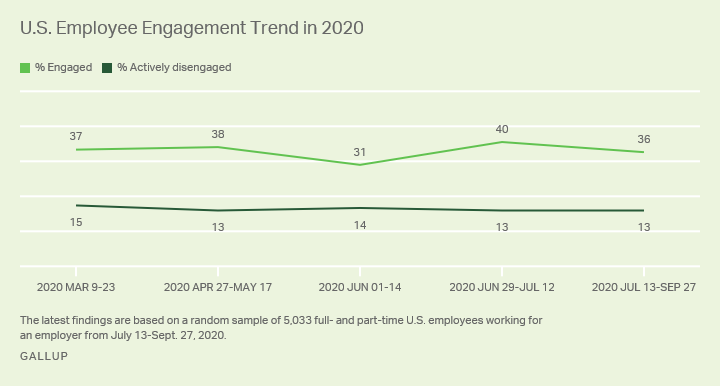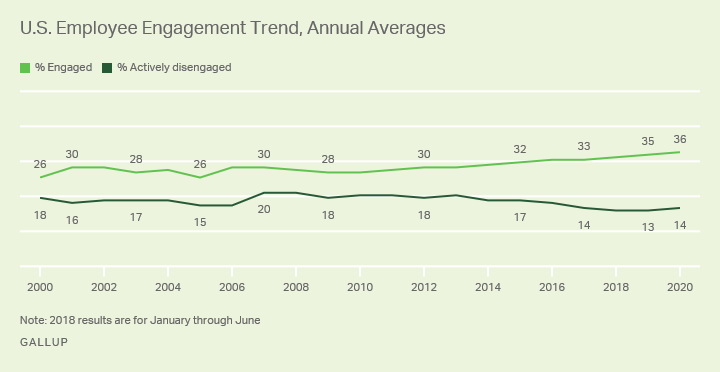Get the highlights from Gallup's latest study across 112,312 business units that finds important ties between employee engagement and 11 performance outcomes -- including profitability and employee wellbeing.
Gallup is closely tracking the engagement and wellbeing of the workforce during this unprecedented time of disruption. We are providing the latest updates for organizational leaders so they can understand the impact on the workplace and what their people need most during this time of rapid change.
After a roller-coaster summer of unprecedented volatility, U.S. employee engagement appears to have settled down.
Employee engagement has been a steady metric without sharp ups and downs since Gallup began tracking it in 2000 -- with the exception of 2020.
This year, engagement levels have fluctuated more than ever before.
But after a wild summer, affected by various combined stressors including the ongoing pandemic and related restrictions, mounting political tension as the election nears, and societal unrest surrounding racial tensions, engagement has reverted back to pre-COVID-19 levels.
The fluctuations were remarkable, though. In early May, employee engagement advanced to a new high of 38% in the U.S. And then, following the killing of George Floyd in late May and subsequent protests and riots, the percentage of engaged employees dropped to 31% as measured from June 1-14.
Shortly following that drop, engagement reached another new high -- 40% in late June to mid-July.
Now, from our most recent measurement spanning July 13 through Sept. 27, the percentage of engaged employees -- those who are highly involved in, enthusiastic about and committed to their work and workplace -- has dropped back to just slightly above the pre-COVID-19 rate of 35%, to 36%.
The percentage of workers who are "actively disengaged" -- those who have miserable work experiences and spread their unhappiness to their colleagues -- in this latest survey remains the same, at 13%. The ratio of engaged to actively disengaged workers from mid-July to the end of September is now 2.8-to-1, down slightly from a 3.1-to-1 ratio in early July. These latest findings are based on a random sample of 5,033 full- and part-time U.S. employees working for an employer from July 13-Sept. 27, 2020.

Line graph of the trend in U.S. employee engagement over the course of 2020 so far. The percentage of actively disengaged employees has held relatively steady -- it was 15% in March and is 13% in the September data update. The percentage of engaged employees has zig-zagged more this year, falling as low as 31% in June and rising as high as 40% in early July. The percentage of engaged employees is 36% in this latest data update.
The remaining 51% of workers are "not engaged" -- they are psychologically unattached to their work and company.
They're also on the lookout for better employment opportunities and will quickly leave their company for a slightly better offer.
Immediately following the killing of George Floyd and the subsequent unrest, the largest decline in employee engagement was among those in managerial or leadership positions, as well as non-White respondents and those with Democratic political party affiliation or independents.
The drop was also sharper for people working on-site versus at home and among blue-collar or service workers. The drop was larger for men than women.
These declines in employee engagement in early June appear to have been short-lived disruptions to the workplace. All the sub-categories where Gallup measured the most substantial engagement drops in early to mid-June have seen significant rebounds.
However, in this most recent 4-percentage-point drop in engagement, the drop was greatest for managers in comparison to executive leaders and individual contributors.
The engagement of managers is critical because they set the tone for the engagement of the people who report to them -- managers affect 70% of the variance in team engagement. They are responsible for keeping employees informed about what is going on in the organization, setting priorities, and providing ongoing feedback and accountability.
In September, 41% of employees strongly agreed that their manager keeps them informed about what is going on in the organization. Unfortunately, managers report higher levels of stress and burnout than the people they manage.
How your company leaders manage managers is extremely important.
Annual Trend in Employee Engagement Continues Steady Rise
Combining Gallup's measurements for 2020 so far -- a sample of 30,278 U.S. workers -- 36% of employees are engaged and 14% are actively disengaged or a ratio of 2.6-to-1 engaged to actively disengaged workers.
If this level of employee engagement were to continue until the end of 2020, it would represent a slight increase from 2019 and another new high in the percentage of engaged workers from Gallup's historic measurement.

Line graph of the annual trend in U.S. employee engagement from 2000 through the 2020 average so far. In 2000, 26% of U.S. employees were engaged, and that figure was up to 35% in 2019. The average for 2020 so far is 36% engaged. In 2000, the percentage of actively disengaged employees was 18%, and that figure was down to 13% in 2019. The average for 2020 so far is 14% actively disengaged.
What Gallup Has Learned From Organizations During COVID-19
With the disruptions of 2020, organizational leaders often ask how they should interpret current employee engagement results or compare them with past measurements given the markedly different circumstances. Are the survey results even useful?
We recommended organizations continue surveying employees during this volatile period -- there is no better time to know what your employees are thinking than during a disruption.
Recent research shows that employee engagement is an even stronger predictor of performance during tough periods such as economic recessions like we're in today.
In 2020, Gallup tracked 190 organizational employee engagement surveys from April through July across more than 300,000 employees in 18 industries. Each organization's survey results in 2020 were compared with similar organizations' employee engagement as measured before the pandemic in 2019. Gallup found the median survey response rate during COVID-19 was 86%, as compared to a median response rate of 85% pre-COVID-19.
Overall levels of engagement and average growth in engagement were not compromised for organizations implementing employee engagement measures and interventions during COVID-19. Taken together with the broader national employee engagement trends, fluctuations in employee engagement should be considered a short-term phenomenon. Even still, acting on employee engagement insights can bring clarity to uncertain times, making this more important than ever.
Why Employee Engagement Is Important
Employee engagement is an even stronger predictor of performance during tough times such as economic recessions like we are in today.
Previous Gallup research has shown that employee engagement is a consistent predictor of many important organizational outcomes across more than two decades, even during massive changes in the economy and technological advances.
Gallup has recently conducted its 10th global meta-analysis of the relationship between employee engagement and performance across 112,312 business and work units in 276 organizations across 54 industries with employees in 96 countries.
When comparing top-quartile with bottom-quartile engagement business units and teams, Gallup found median percentage differences of:
- 10% in customer loyalty/engagement
- 23% in profitability
- 18% in productivity (sales)
- 14% in productivity (production records and evaluations)
- 18% in turnover for high-turnover companies (those with more than 40% annualized turnover)
- 43% in turnover for low-turnover companies (those with 40% or lower annualized turnover)
- 64% in safety incidents (accidents)
- 28% in shrinkage (theft)
- 81% in absenteeism
- 58% in patient safety incidents (mortality and falls)
- 41% in quality (defects)
- 66% in wellbeing (thriving employees)
- 13% in organizational citizenship (participation)
Findings from the study indicate that, across companies, business/work units scoring in the top half on employee engagement more than double their odds of success compared with those in the bottom half.
Those at the 99th percentile have nearly five times the success rate of those at the 1st percentile.
Previous Gallup research has shown that employee engagement is very changeable inside organizations when leaders focus on the right practices.
Gallup will continue to track the engagement and wellbeing of the workforce during this unprecedented year of disruption and change and continue to provide the latest updates for organizational leaders.
Keep your employees' engagement trending upward:
- Get the highlights from the world's largest study on employee engagement to understand how to measure and improve your employees' performance.
- Find out why the Q12 employee engagement survey is the best way to measure employee engagement.
- Read about the three personas of engagement and what highly engaged employees do differently for your company.




